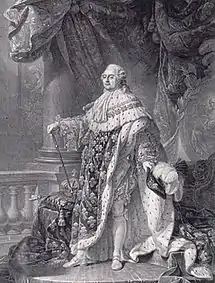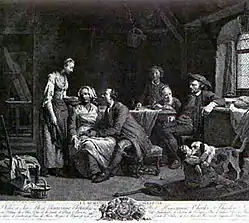Charles Clément Balvay
Charles Clément Balvay (23 May 1756, Paris – 23 March 1822, Paris), known as Bervic, was a French engraver mainly working in intaglio and exclusively in burin. Due to an error in transcribing the baptismal register, he is also now known as Jean Guillaume Balvay.


He served his first apprenticeship under Jean-Baptiste Le Prince, then left aged 14 for the studio of the engraver Jean-Georges Wille. When he was 18, he won first prize for drawing at the Académie royale de peinture et de sculpture, of which he was elected a member in 1784. He became a member of the Classe de Beaux-Arts (Fine Arts Section) of the Institut Impérial de France in 1803 and authored the chapter on engraving for the Institut's reports to the Emperor in 1808 on the progress of the arts, literature and sciences since 1789.[1] He won many prizes and his drawing talents were particularly appreciated.
In 1809, Balvay was elected an associate member, fourth class, of the Royal Institute of the Netherlands, predecessor to the Royal Netherlands Academy of Arts and Sciences.[2]
Balvay married the painter Marie-Marguerite Carreaux de Rosemond in 1788, but she died later that year. In 1791 he remarried to Marie-Madeleine Bligny, who died in 1795.[3]
Works
- Gabriel Senac de Meilhan (1783) after Joseph Siffred Duplessis
- Louis XVI (1790) after Antoine-François Callet
- Saint John in the desert after Raphael
- The Education of Achilles after Jean-Baptiste Regnault
- The Declaration after Louis Rolland Trinquesse
- The Oath after Louis Rolland Trinquesse
- Le Laocoon, after the classical sculpture, from a drawing by Pierre Bouillion, issued in Le Musée français, 1812.
References
- Edited by U. van de Sandt, Rapports à l’Empereur sur le progrès des sciences, des lettres et des arts depuis 1789 [Paris: Belin, 1989], pp. 240-45
- "C.C. Bervic (1756 - 1832)". Royal Netherlands Academy of Arts and Sciences. Retrieved 22 May 2016.
- Profile of Marie-Marguerite Carreaux de Rosemond at the Dictionary of Pastellists Before 1800.